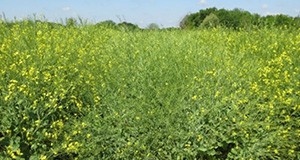
Carinata has been grown commercially for several years on the Canadian prairie and more recently in the US northern plains as a summer crop. For the past four years, UF has been conducting research to evaluate various management practices that allow incorporation of carinata into current cropping systems as a winter crop with minimal modification to existing infrastructure in the southeastern US. This 8-page fact sheet is a major revision that discusses carinata characteristics, biology, nutrient management, tillage, variety selection, planting dates, seeding depth, seeding rate, row spacing, weed management, disease management, insect management, harvest management, economics, and crop insurance. Written by Ramdeo Seepaul, Christine M. Bliss, David L. Wright, Jim J. Marois, Ramon G. Leon, Nicholas Dufault, Sheeja George, and Steve M. Olson, and published by the UF Agronomy Department, December 2014. Revised October 2015.
http://edis.ifas.ufl.edu/ag389
Tag: Ramon G. Leon
Doveweed (Murdannia nudiflora) Control in Warm-Season Turfgrass Species
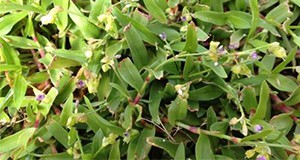 Doveweed is an aggressive, naturalized summer annual weed that rapidly invades warm-season turfgrass species, especially in residential lawns, and few herbicides can effectively control it. Because of these challenges, a well-designed management strategy is necessary for doveweed control. This 4-page fact sheet describes identification, growth requirements, chemical control and cultural practices. Written by Ramon G. Leon and Bryan Unruh, and published by the UF Department of Agronomy, June 2015.
Doveweed is an aggressive, naturalized summer annual weed that rapidly invades warm-season turfgrass species, especially in residential lawns, and few herbicides can effectively control it. Because of these challenges, a well-designed management strategy is necessary for doveweed control. This 4-page fact sheet describes identification, growth requirements, chemical control and cultural practices. Written by Ramon G. Leon and Bryan Unruh, and published by the UF Department of Agronomy, June 2015.
http://edis.ifas.ufl.edu/ag395
Biochar Effects on Weed Management
 Biochar can potentially provide better conditions in the soil to increase plant growth. However, research has shown that weed species show minimal changes in germination and emergence patterns with the addition of biochar. Regardless, if biochar is used in the field it is important to monitor for changes in weed populations. This is especially important because biochar can decrease herbicide efficacy. This 2-page fact sheet was written by Neeta Soni, Ramon G. Leon, John E. Erickson, and Jason A. Ferrell, and published by the UF Department of Agronomy, March 2015. (Photo: Neeta Soni)
Biochar can potentially provide better conditions in the soil to increase plant growth. However, research has shown that weed species show minimal changes in germination and emergence patterns with the addition of biochar. Regardless, if biochar is used in the field it is important to monitor for changes in weed populations. This is especially important because biochar can decrease herbicide efficacy. This 2-page fact sheet was written by Neeta Soni, Ramon G. Leon, John E. Erickson, and Jason A. Ferrell, and published by the UF Department of Agronomy, March 2015. (Photo: Neeta Soni)
http://edis.ifas.ufl.edu/ag390
Hairy Indigo Control in Peanut
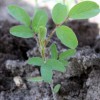 Hairy indigo is an annual legume that was introduced to Florida as a forage crop. It has since escaped cultivation and can be a troublesome weed in some crop settings, particularly in peanut production, since we are attempting to control a legume weed in a legume crop. This 2-page fact sheet was written by Jason Ferrell, Blaire Colvin, and Ramon Leon, and published by the UF Department of Agronomy, March 2015. (Photo by Blaire Colvin, UF/IFAS)
Hairy indigo is an annual legume that was introduced to Florida as a forage crop. It has since escaped cultivation and can be a troublesome weed in some crop settings, particularly in peanut production, since we are attempting to control a legume weed in a legume crop. This 2-page fact sheet was written by Jason Ferrell, Blaire Colvin, and Ramon Leon, and published by the UF Department of Agronomy, March 2015. (Photo by Blaire Colvin, UF/IFAS)
http://edis.ifas.ufl.edu/ag391
Carinata Production in Florida
 Brassica carinata is a promising oilseed crop with great potential for profitable cultivation in Florida. Its high oil content and favorable fatty acid profile make it suitable for the biofuel industry, especially as a biojet fuel. The UF/IFAS North Florida Research and Education Center (NFREC) in Quincy, Florida, has been working to identify advanced carinata genotypes that are high yielding (seed and oil), disease resistant, early maturing, and adapted to Florida. The work at NFREC is being done in conjunction with Agrisoma Biosciences Inc., a crop company that has the world’s largest collection of carinata germplasm. This 6-page fact sheet’s “Agronomic Management” section provides recommendations resulting from NFREC’s research. was written by C. M. Bliss, R. Seepaul, D. L. Wright, J. J. Marois, R. Leon, N. Dufault, S. George, and S. M. Olson, and published by the UF Department of Agronomy, December 2014.
Brassica carinata is a promising oilseed crop with great potential for profitable cultivation in Florida. Its high oil content and favorable fatty acid profile make it suitable for the biofuel industry, especially as a biojet fuel. The UF/IFAS North Florida Research and Education Center (NFREC) in Quincy, Florida, has been working to identify advanced carinata genotypes that are high yielding (seed and oil), disease resistant, early maturing, and adapted to Florida. The work at NFREC is being done in conjunction with Agrisoma Biosciences Inc., a crop company that has the world’s largest collection of carinata germplasm. This 6-page fact sheet’s “Agronomic Management” section provides recommendations resulting from NFREC’s research. was written by C. M. Bliss, R. Seepaul, D. L. Wright, J. J. Marois, R. Leon, N. Dufault, S. George, and S. M. Olson, and published by the UF Department of Agronomy, December 2014.
http://edis.ifas.ufl.edu/ag389
Violet Biology and Management in Turf
 Violets (Viola spp.) are diverse winter annuals and perennials. Perennials form rhizomes or long stolons. Many have heart-shaped leaves on long petioles and have a rosette growth habit. Some have linear leaves and others have palmate leaves. Flowers are generally purple, but can be white, pink or yellow. They reproduce by seed or, when produced, rhizomes. This 2-page fact sheet was written by Darcy E. P. Telenko, Barry J. Brecke, Ramon Leon, and J. Bryan Unruh, and published by the UF Department of Environmental Horticulture, December 2013.
Violets (Viola spp.) are diverse winter annuals and perennials. Perennials form rhizomes or long stolons. Many have heart-shaped leaves on long petioles and have a rosette growth habit. Some have linear leaves and others have palmate leaves. Flowers are generally purple, but can be white, pink or yellow. They reproduce by seed or, when produced, rhizomes. This 2-page fact sheet was written by Darcy E. P. Telenko, Barry J. Brecke, Ramon Leon, and J. Bryan Unruh, and published by the UF Department of Environmental Horticulture, December 2013.
http://edis.ifas.ufl.edu/ep496
Spreading Dayflower Biology and Management in Turf
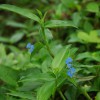 Spreading dayflower (Commelina diffusa) is a succulent annual that produces freely branched smooth stems. Leaves are broadly lance-shaped with closed sheaths. Sheaths are short with a few soft hairs on the upper margin. Flowers have three blue petals in a leaf-like structure open on the margins. Reproduction occurs via seed and stem fragments. This 2-page fact sheet was written by J. Bryan Unruh, Darcy E. P. Telenko, Barry J. Brecke, and Ramon Leon, and published by the UF Department of Environmental Horticulture, December 2013.
Spreading dayflower (Commelina diffusa) is a succulent annual that produces freely branched smooth stems. Leaves are broadly lance-shaped with closed sheaths. Sheaths are short with a few soft hairs on the upper margin. Flowers have three blue petals in a leaf-like structure open on the margins. Reproduction occurs via seed and stem fragments. This 2-page fact sheet was written by J. Bryan Unruh, Darcy E. P. Telenko, Barry J. Brecke, and Ramon Leon, and published by the UF Department of Environmental Horticulture, December 2013.
http://edis.ifas.ufl.edu/ep497
Black Medic Biology and Management in Turf
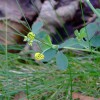 Black medic (Medicago lupulina) is a dark green annual with spreading, prostrate growth. Leaves are alternate with three leaflets on square stems. Leaflets are obovate to elliptic, toothed near the tip, and have a small spur on the tip. Bright yellow flowers are produced in tight, compressed clusters at leaf axils. Reproduction occurs via seed in tightly coiled black seed pods. This 2-page fact sheet was written by Barry J. Brecke, Ramon Leon, J. Bryan Unruh, and Darcy E. P. Telenko, and published by the UF Department of Environmental Horticulture, December 2014.
Black medic (Medicago lupulina) is a dark green annual with spreading, prostrate growth. Leaves are alternate with three leaflets on square stems. Leaflets are obovate to elliptic, toothed near the tip, and have a small spur on the tip. Bright yellow flowers are produced in tight, compressed clusters at leaf axils. Reproduction occurs via seed in tightly coiled black seed pods. This 2-page fact sheet was written by Barry J. Brecke, Ramon Leon, J. Bryan Unruh, and Darcy E. P. Telenko, and published by the UF Department of Environmental Horticulture, December 2014.
http://edis.ifas.ufl.edu/ep494
Sedge Biology and Management in Turf
 Members of the sedge family have leaves that are composed of a blade, sheath, and ligule. The leaf sheath is closed and the ligule is often absent, and when present is tiny. Stem structure is often triangular.This 3-page fact sheet was written by D. E. P. Telenko, Ramon Leon, J. Bryan Unruh, and B. J. Brecke, and published by the UF Department of Environmental Horticulture, December 2014.
Members of the sedge family have leaves that are composed of a blade, sheath, and ligule. The leaf sheath is closed and the ligule is often absent, and when present is tiny. Stem structure is often triangular.This 3-page fact sheet was written by D. E. P. Telenko, Ramon Leon, J. Bryan Unruh, and B. J. Brecke, and published by the UF Department of Environmental Horticulture, December 2014.
http://edis.ifas.ufl.edu/ep492
Old World Diamond-Flower Biology and Management in Turf
 Old world diamond-flower is a smooth, spreading summer annual. It has branched stems with opposite, narrow leaves. Flowers are white, usually with two or more on long stalks extending from the tip of a common long stalk. Flowers occur from midsummer until frost. Reproduction occurs by seed. Found in moist areas, especially areas that have been disturbed. This 2-page fact sheet was written by Darcy E. P. Telenko, Barry J. Brecke, Ramon Leon, and J. Bryan Unruh, and published by the UF Department of Environmental Horticulture, December 2013.
Old world diamond-flower is a smooth, spreading summer annual. It has branched stems with opposite, narrow leaves. Flowers are white, usually with two or more on long stalks extending from the tip of a common long stalk. Flowers occur from midsummer until frost. Reproduction occurs by seed. Found in moist areas, especially areas that have been disturbed. This 2-page fact sheet was written by Darcy E. P. Telenko, Barry J. Brecke, Ramon Leon, and J. Bryan Unruh, and published by the UF Department of Environmental Horticulture, December 2013.
http://edis.ifas.ufl.edu/ep493
Erect and Prostrate Spurge Biology and Management in Turf
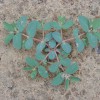 Erect and prostrate spurges are erect or upright annuals with branched stems. Leaves are opposite and not equal. Stems produce “milky sap.” A large number of spurge species occur in Florida. Reproduction occurs via seed. This 2-page fact sheet was written by J. Bryan Unruh, Darcy E. P. Telenko, Barry J. Brecke, and Ramon Leon, and published by the UF Department of Environmental Horticulture, December 2013.
Erect and prostrate spurges are erect or upright annuals with branched stems. Leaves are opposite and not equal. Stems produce “milky sap.” A large number of spurge species occur in Florida. Reproduction occurs via seed. This 2-page fact sheet was written by J. Bryan Unruh, Darcy E. P. Telenko, Barry J. Brecke, and Ramon Leon, and published by the UF Department of Environmental Horticulture, December 2013.
http://edis.ifas.ufl.edu/ep495
2013 Cotton Defoliation and Harvest Aid Guide
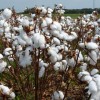 In Florida, cotton requires about 155 days of growth from planting to harvest. Throughout the growing season, growers must make important management decisions about defoliation, boll opening, and regrowth suppression. These factors can affect the quality and storage time if the crop is put into modules. The greatest losses in quality are caused by stain from poorly defoliated plants or regrowth and moisture from green tissue. This 8-page fact sheet was written by R.G. Leon, D. L. Wright and B. J. Brecke, and published by the UF Department of Agronomy, October 2013.
In Florida, cotton requires about 155 days of growth from planting to harvest. Throughout the growing season, growers must make important management decisions about defoliation, boll opening, and regrowth suppression. These factors can affect the quality and storage time if the crop is put into modules. The greatest losses in quality are caused by stain from poorly defoliated plants or regrowth and moisture from green tissue. This 8-page fact sheet was written by R.G. Leon, D. L. Wright and B. J. Brecke, and published by the UF Department of Agronomy, October 2013.
http://edis.ifas.ufl.edu/ag188
Weed Management Guide for Florida Lawns
 Weeds can be defined as unwanted plants or plants growing out of place. Proper identification and some understanding of how and why weeds are present in a lawn are important when selecting the best control strategy. Knowing whether or not weeds were previously present in a particular area also helps homeowners prepare control measures in the future. Weed control should be a carefully planned and coordinated program. This 8-page fact sheet was written by J.Bryan Unruh, Ramon G. Leon, Barry J. Brecke, and Laurie E. Trenholm, and published by the UF Department of Environmental Horticulture, July 2013.
Weeds can be defined as unwanted plants or plants growing out of place. Proper identification and some understanding of how and why weeds are present in a lawn are important when selecting the best control strategy. Knowing whether or not weeds were previously present in a particular area also helps homeowners prepare control measures in the future. Weed control should be a carefully planned and coordinated program. This 8-page fact sheet was written by J.Bryan Unruh, Ramon G. Leon, Barry J. Brecke, and Laurie E. Trenholm, and published by the UF Department of Environmental Horticulture, July 2013.
http://edis.ifas.ufl.edu/ep141